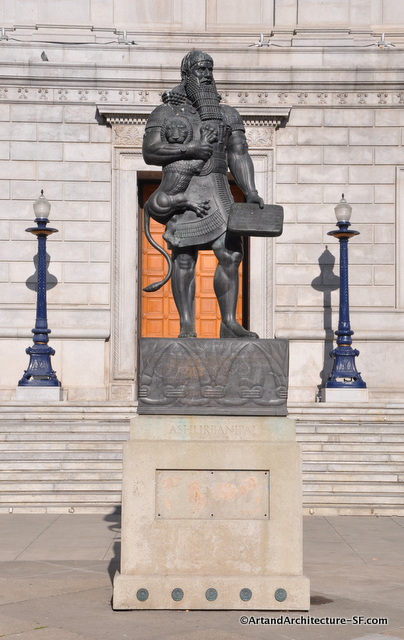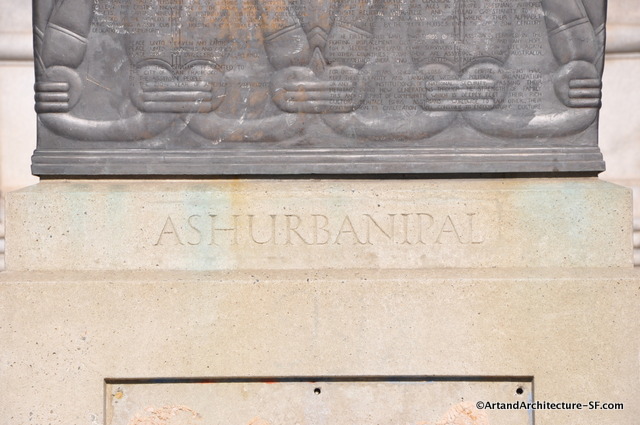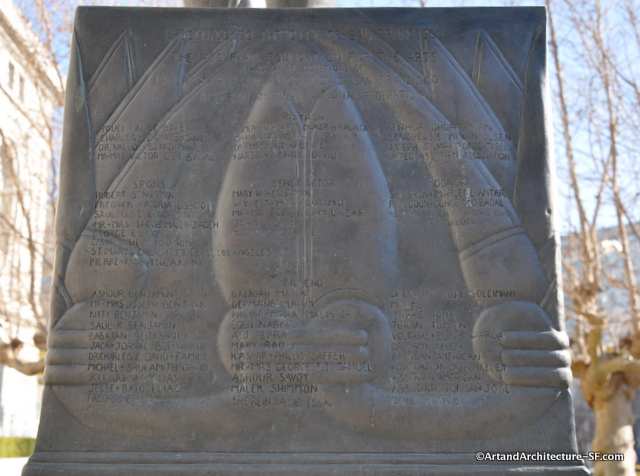 Ashurbanipal by sculptor Fred Parhad sits on the sidewalk of the Asian Art Museum, facing the San Francisco Library. The sculpture shows Asurbanipal wearing a short tunic and holds a lion cub in his right arm. The figure stands on a concrete base, with bronze plaque and rosettes. The statue shows the king grasping a lion cub and holding a clay tablet which bears this dedication in cuneiform:
Ashurbanipal by sculptor Fred Parhad sits on the sidewalk of the Asian Art Museum, facing the San Francisco Library. The sculpture shows Asurbanipal wearing a short tunic and holds a lion cub in his right arm. The figure stands on a concrete base, with bronze plaque and rosettes. The statue shows the king grasping a lion cub and holding a clay tablet which bears this dedication in cuneiform:
Ashurbanipal was an Assyrian king, the son of Esarhaddon and the last great king of the Neo-Assyrian Empire (668 BC – c. 627 BC). He established the first systematically organized library in the ancient Middle East, the Library of Ashurbanipal, which survives in part today at Nineveh.
 *
*
The Inscription reads: The Assyrians formed one of the earliest great empires in the world. Their civilization dates from 2700 B.C. with the important cultural centers at Ashur and Nineveh north of modern Baghdad. Beginning as a river civilization in Mesopotamia between the Tigris and Euphrates, the empire spread east and west to touch the lives of all Near Eastern people.
This is a statue of Ashurbanipal, one of the great kings of Assyria. A noted patron of the arts, he helped to build a culture that inspired nations from Persia to the Mediterranean Sea. The bas-reliefs in his palace are among the finest examples of ancient sculpture. Ashurbanipal ruled during the 7th century B.C. At a time when both Egypt and Babylon were under the Assyrian banner. Ashurbanipal had a personal love of learning which prompted him to collect existing knowledge of the known world in cuneiform tablets. His capital, Nineveh is distinguished for its vast collection, recorded as the world’s first great library.
The language of the Assyrians, Aramaic was spoken by Christ and widely used throughout the Near East by Israelites, Arabs, Persians and others for centuries. It remained the spoken and written language of the Assyrians down to the present time. Their empire lasted 1000 years until the fall of Nineveh in 612 B.C.
During the ensuing centuries of chaotic political struggle, first between the Persians and Romans, and later between Christians and Muslims, the Assyrians sought refuge in the difficult mountainous terrain of their ancient empire where succeeding governments and warring armies passed them by.
Among the first converts to Christianity, they preserved and transmitted the culture of classical Greece to the Moors who advanced it during the Dark Ages in Europe. Assyrians authored exquisite religious literature and spread Christianity to the Asiatic east as far as India and to China where their alphabet remained in use by the ruling houses until the early 20th century.
In the First World War two-thirds of the Assyrians perished in the fighting. Displacement cost them their homes, wealth and any hope for a secure homeland. Many survivors left to begin life again in other countries. Today there are Assyrians in Europe, Australia, South America, India and the United States
Assyrians have kept their identity and language without political organization or any of the institutions of national security, passing their heritage on to new generations through the strength of family ties and a spirit of community which is deeply felt. Their rich cultural heritage binds Assyrians worldwide to each other. Their contribution to civilization will continue to enrich world culture.
The sculptor Fred Parhad was born in Baghdad, Iraq in 1947. His mother, Bella Toma was born in Iran, His father, Dr. Luther Parhad, was born in Iraq where his grandfather Dr. Baba Parhad had taken the family after the massacres in Northern Iran at the close of World War I. His early years were spent in Iraq, Iran and Kuwait where his father served as the national Director of Health.
His interest in sculpture began early and continued through college at UC Berkeley, though he did not make it a career choice until 1976 when he moved to New York City.


